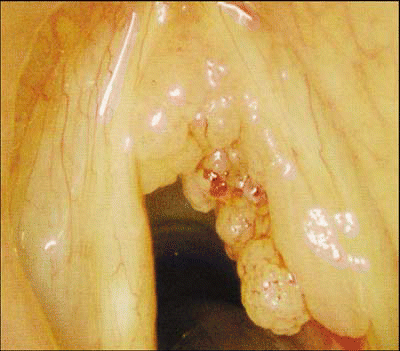Although most respiratory papillomatosis starts in childhood, some patients develop symptoms in adulthood. While adult-onset disease is milder, patients often still require multiple surgeries to be free of the characteristic lesions and the associated hoarseness.
Explore This Issue
July 2006In a joint phone interview, two leading experts in respiratory papillomatosis discussed the diagnosis and management of adult patients. Blake Simpson, MD, is Associate Professor and Deputy Chair of the Otolaryngology–Head and Neck Center at the University of Texas Health Science Center in San Antonio. Clark A. Rosen, MD, is Associate Professor of Otolaryngology at the University of Pittsburgh School of Medicine (Pa.), where he is the Director of the Voice Center.
“Adult respiratory papillomatosis is going to be a much less aggressive course than what otolaryngologists are used to seeing with children,” said Dr. Simpson. “These lesions grow slower, and patients go longer intervals between surgeries. Adult patients do better than children.”
Although the route of transmission is known to be perinatal in children, the transmission of adult-onset disease is unknown, he added. “My theory is that people with adult onset were probably were born with it,” he said. “It lives in the tissue of their larynx and with aging, the immune surveillance system isn’t as vigilant, and the papilloma starts growing.” He noted that this development can happen at any age. “I’ve seen it surface in 70-year-olds.”
People with adult-onset disease, then, may have had a perinatal transmission that has been dormant throughout their lives. “When you take the papilloma lesion off along with some normal adjacent tissue, you’ll find the virus in both the affected and the apparently healthy tissue,” Dr. Simpson said. “I think this phenomenon explains why the condition is milder in adults: they may have been living with it all their lives. There are a couple of theories about how adults get it, but perinatal transmission and subsequent dormancy is the only one that makes sense regarding how adults get the disease.”
Although the route of transmission is known to be perinatal in children, the transmission of adult-onset disease is unknown.

What to Look For
Patients with adult respiratory papillomatosis typically have little unique in their presentation, Dr. Simpson said. “If a 20- to 60-year-old patient says he or she has been hoarse for the past several years, there could be many causes,” he said. “They typically have gradually progressive hoarseness.” Again, this report alone would not lead down the papillomatosis pathway. “However, if the patient says, ‘I’ve had two surgeries with polyps removed,’ papillomatosis may be the cause. The whole differentiating thing about papilloma is that it recurs. If it recurs, it’s almost always papilloma.”
Leave a Reply